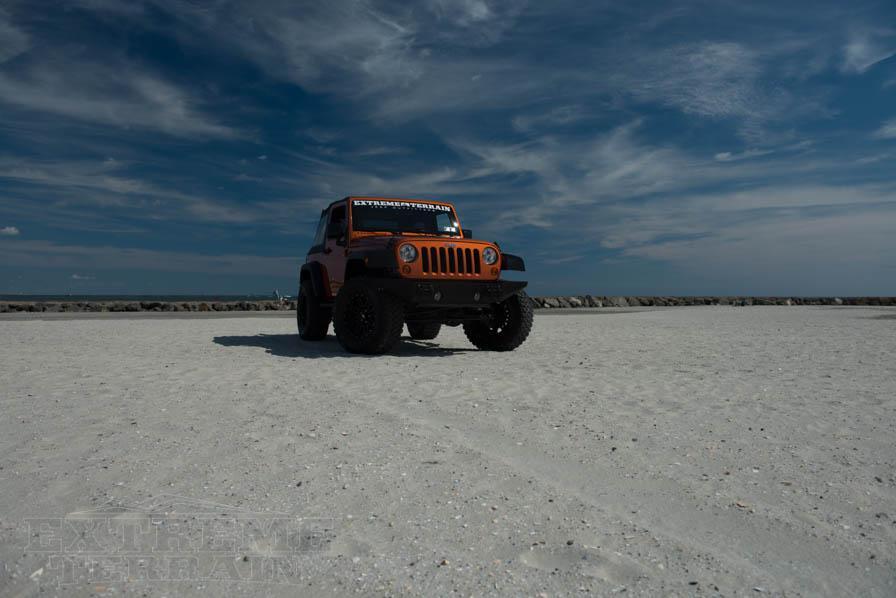Most Popular in Wrangler Winches
Wrangler Products
How to Off-Roading Your Wrangler at the Beach
Written By:
SHOP WRANGLER WINCHES
Haivng a back up plan is always a good idea when off-roading in either sand or mud. A quality winch should be part of that back up plan. There's a variety of options and strengths depending on your needs so you can keep your Jeep safe even when off-roading alone.
Shop PartsOne of the best off-roading locations to visit with your Jeep is the beach. However, there are several things to bring along and steps to take in order to have a great time. This guide will help explain and detail what you should bring along and what to do while at the beach.

Items to Bring
-
Tire gauge
-
Tire valve bleeders
-
Air compressor
-
Shovel
-
Recovery strap
-
Tow strap
-
Sand/Land anchor
Arriving & Prepping at the Beach
The first thing you should do when your tires touch the sand is lower their air pressure. By lowering the air pressure you spread the tire’s footprint and allow for better traction. A good air pressure to start with is the high teens to low twenties. Using the tire valve bleeders, screw them onto the tire’s air valve to quickly deflate the tire to the predetermined amount, confirming the pressure with the tire gauge. Next, do a quick visual inspection of your drive shaft and all steering components, sand creates tremendous resistance and stress on these components. Any weak points have a big potential of failure under the heat and stress of the beach.

Driving across the sand
Engage the 4-hi mode of the Jeep, and if you find yourself stuck or the terrain is too demanding, you could transition to 4-lo. Next maintain a steady easy pace. You’re dealing with a high resistance terrain under high temperatures; there is a significant potential of overheating. By maintaining a nice steady pace you ensure a good operating temperature and better traction. Also aim for lower more densely packed sand, avoiding large sand dunes, for both ecological and stability reasons. Similar to driving in soft snow, your Jeep will sink if standing still or if the wheels are spinning too fast.

Recovering your jeep in sand
Despite all your prep work and proper driving style, the Jeep is stuck. Here are the steps you should follow to get yourself out.
Shovel: Often times, just simply shoveling the sand around the wheels is enough to regain traction and get you moving again.
Recovery strap: Although it might look similar to a “tow strap” a recovery strap has elasticity to build up momentum when pulled. A tow strap has no elasticity and is used to pull the free-rolling vehicle back onto the road or a safer location for repair. Assuming there is another vehicle nearby to help pull you out, properly attach the strap to an appropriate anchoring point such as D-Rings on after market bumpers or the tow hooks on the factory bumper. Never attach a recovery strap to the Jeep’s axle or looped around the bumper. Keep in mind most tow straps come with steel hooks. It's better to find a tow strap with looped ends to avoid any injury or damage while towing.
Self-recovery: In the event there’s no other vehicle and you have a winch, you can try two self-recovery methods. The first is through the use of a sand or land anchor. This handy tool looks like a shovel blade with a bent L. The end of the L faces the Jeep, and attaching the winch cable to the end of the bar anchors it to the Jeep. As you engage the winch, the blade will dig into the sand and pull the Jeep. The more it’s pulled the deeper it will dig into the sand and provide more of an anchoring point for recovery. The second method is an alternative to the sand anchor. Digging a deep hole, attach your winch cable to your spare tire, cover it with sand, and initiate the recovery by engaging the winch. This last method is obviously more labor intensive, so if you plan on off-roading on the beach alone often, it’s good to invest in an anchor.

Location, Location, Location
Make sure you have a proper exit path in the event you are still on the beach when the tide rises. When you are ready to leave, make your way back onto the main road, once off the sand, disengage the 4wd system and inspect the Jeep for any possible damage. Finally, inflate your tires with the air compressor to the proper PSI. Properly equipping your Jeep with the items listed above before heading out as well as following the tips mentioned in this article will ensure you have a great time at the beach












![[SC203P] اندر كفر - فورد F-150 – صندوق التخزين المتأرجح ( جهة الراكب ) (2015-2022)](/web/image/product.template/2312/image_1920/%5BSC203P%5D%20%D8%A7%D9%86%D8%AF%D8%B1%20%D9%83%D9%81%D8%B1%20-%20%D9%81%D9%88%D8%B1%D8%AF%20F-150%20%E2%80%93%20%D8%B5%D9%86%D8%AF%D9%88%D9%82%20%D8%A7%D9%84%D8%AA%D8%AE%D8%B2%D9%8A%D9%86%20%D8%A7%D9%84%D9%85%D8%AA%D8%A3%D8%B1%D8%AC%D8%AD%20%28%20%D8%AC%D9%87%D8%A9%20%D8%A7%D9%84%D8%B1%D8%A7%D9%83%D8%A8%20%29%20%282015-2022%29?unique=32e2d66)
![[SC203D] اندر كفر - فورد F-150 – صندوق التخزين المتأرجح ( جهة السائق ) (2015-2022)](/web/image/product.template/2311/image_1920/%5BSC203D%5D%20%D8%A7%D9%86%D8%AF%D8%B1%20%D9%83%D9%81%D8%B1%20-%20%D9%81%D9%88%D8%B1%D8%AF%20F-150%20%E2%80%93%20%D8%B5%D9%86%D8%AF%D9%88%D9%82%20%D8%A7%D9%84%D8%AA%D8%AE%D8%B2%D9%8A%D9%86%20%D8%A7%D9%84%D9%85%D8%AA%D8%A3%D8%B1%D8%AC%D8%AD%20%28%20%D8%AC%D9%87%D8%A9%20%D8%A7%D9%84%D8%B3%D8%A7%D8%A6%D9%82%20%29%20%282015-2022%29?unique=a98cb59)
![[SC302P] اندر كفر – صندوق التخزين المتأرجح – رام 1500- (2019) - ( جهة الراكب )](/web/image/product.template/3465/image_1920/%5BSC302P%5D%20%D8%A7%D9%86%D8%AF%D8%B1%20%D9%83%D9%81%D8%B1%20%E2%80%93%20%D8%B5%D9%86%D8%AF%D9%88%D9%82%20%D8%A7%D9%84%D8%AA%D8%AE%D8%B2%D9%8A%D9%86%20%D8%A7%D9%84%D9%85%D8%AA%D8%A3%D8%B1%D8%AC%D8%AD%20%E2%80%93%20%D8%B1%D8%A7%D9%85%201500-%20%282019%29%20-%20%28%20%D8%AC%D9%87%D8%A9%20%D8%A7%D9%84%D8%B1%D8%A7%D9%83%D8%A8%20%29?unique=a98cb59)
![[SC302D] اندر كفر – صندوق التخزين المتأرجح – رام 1500- (2019)- ( جهة السائق )](/web/image/product.template/3464/image_1920/%5BSC302D%5D%20%D8%A7%D9%86%D8%AF%D8%B1%20%D9%83%D9%81%D8%B1%20%E2%80%93%20%D8%B5%D9%86%D8%AF%D9%88%D9%82%20%D8%A7%D9%84%D8%AA%D8%AE%D8%B2%D9%8A%D9%86%20%D8%A7%D9%84%D9%85%D8%AA%D8%A3%D8%B1%D8%AC%D8%AD%20%E2%80%93%20%D8%B1%D8%A7%D9%85%201500-%20%282019%29-%20%28%20%D8%AC%D9%87%D8%A9%20%D8%A7%D9%84%D8%B3%D8%A7%D8%A6%D9%82%20%29?unique=a98cb59)